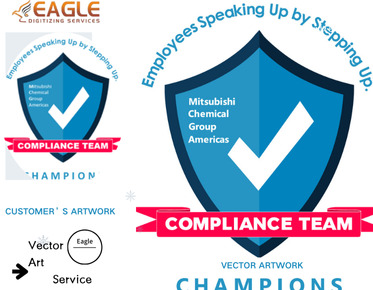Reusability of Screen Printing Screens: Exploring Sustainability in Screen Printing
Screen printing is a popular technique used in the production of textiles, signs, and other commercial imagery. One of the key aspects that influences the sustainability of screen printing is the ability to reuse screens. In this blog, we'll investigate whether screen printing screens are reusable, explore the implications for environmental sustainability, and discuss the role digitizing services like Eagle Digitizing play in enhancing screen printing efficiencies.
Understanding Screen Printing and Screen Reusability
Screen printing involves using a mesh to transfer ink onto a substrate, except in areas made impermeable to the ink by a blocking stencil. Traditionally, screens are made from materials like silk, polyester, or nylon, and substrates can range from textiles to paper and even plastic. The reusability of these screens is a crucial factor in determining the cost-effectiveness and environmental impact of screen printing. In essence, yes, screen printing screens are reusable. However, several factors influence just how often they can be reused, including the type of materials used for the screens, the inks, and the precision with which old stencils can be removed and new images applied.
Factors Influencing Screen Reusability
A big factor in the reusability of a screen is the cleaning and reclaiming process. Properly cleaning the screens is essential to ensuring their longevity. The emulsion or stencil needs to be removed thoroughly to prepare the screen for the next design. The quality of the mesh is also a critical component; screens made from higher quality materials are generally more durable and thus more reusable. Ink residues, especially when using plastisol inks, can be challenging to remove completely, sometimes affecting the screen's lifespan.
In addition to material quality, the number of times a screen can be reused also depends on the image being printed. Complex, detailed images require more frequent cleaning and might wear out the screen faster than simpler designs. This is where vector art services from companies like Eagle Digitizing become crucial, allowing for high-precision stencil creation that can extend a screen's useful life.
The Process of Reclaiming Screens
The reclaiming process involves several steps: removing ink, stripping away the emulsion, and sometimes using chemical treatments to ensure that the screen mesh is perfectly clean. Innovations in the reclaiming process, such as the use of eco-friendly cleaning agents and reclaiming systems, can enhance the screen's reusability and sustainability of the entire screen printing process. Many screen printing shops are adopting better cleaning practices and investing in tools that help maintain their screens for multiple uses.
Environmental Implications
From an environmental standpoint, the reuse of printing screens is beneficial as it reduces waste and the need for manufacturing new screens for each production run. This not only saves resources but also reduces the industrial footprint associated with screen production and disposal. Therefore, optimizing screen reusability aligns with broader sustainability goals within the printing industry. Companies offering vector conversion services, such as digitizing for embroidery, often highlight their roles in helping achieve these efficiencies by providing precise vector conversions that facilitate easy stencil setup and cleanup.
How Eagle Digitizing Enhances Screen Printing Processes
Effective digitizing solutions can vastly improve the sustainability of screen printing. Eagle Digitizing, a leading name in vector art services, offers comprehensive solutions to streamline the preparation of artwork for screen printing. Their vector to raster conversion service allows artwork to be precisely translated into stencils, reducing errors and waste. This precision not only minimizes costs associated with errors and retries but also ensures that screens can be reclaimed more easily and reused multiple times with little or no degradation in quality.
Future Directions in Screen Printing Sustainability
The future of screen printing looks promising as advancements in materials and processes continue to promote sustainability. Research into biodegradable screen emulsions, water-based inks, and more efficient reclaiming chemicals will likely make the process even more eco-friendly. The digitizing industry, with its innovations in vector art conversion and related services, will play a supportive role in these advancements, ensuring that the integration of technology keeps pace with sustainable practices. By embracing these advancements, screen printers can expect to see longer-lasting screens and more environmentally friendly operations.
Screen printing continues to evolve with time, merging traditional methods with digital enhancements for better efficiency and sustainability. As these two aspects converge, the reusability of screens forms a crucial part of achieving an eco-positive footprint in the printing industry. Will advances in materials further extend the life of screens? How will digitizing services further transform the printing industry toward sustainability? The direction screen printing takes will depend largely on ongoing innovations and the commitment of businesses to invest in both current technologies and sustainable practices.


.png)
.png)